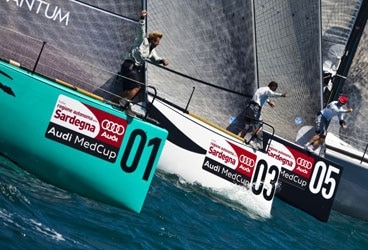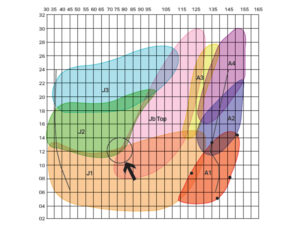
bowman perspective 368
In sailboat racing there are those who “do bow” and those who simply own the bow, particularly when it comes to starting big keelboats in rush-hour traffic. The master of the pointy end shoulders a great deal of pressure as the prep flag drops and boats pile on top of one another. Call the line right and the bowman is a hero; pull the trigger too early and he or she must live with the consequences for the rest of the race.
“Regattas are won and lost by one or two points,” says Curtis Florence, hailed as one of the world’s best bowmen by Rolex Yachtsman of the Year Terry Hutchinson, “and that makes starts pretty important.”
Florence, 39, a Farr 40 and Mumm 30 world champion bowman, knows how to get his team on the line and off and running. After witnessing his prowess onboard the Farr 40 Barking Mad, we pressed him for his insights on how to conduct starting-line affairs from the front of the boat.
In the pre-start, what’s the best way to make sure the front of the boat knows what the back of the boat intends to do?
At about 3 to 4 minutes, go back to the mast, look at the tactician, and ask, “What’s your plan?” You want their ideal starting strategy so you have an idea of where they want to go.
As you get into the final approach, what’s the back-and-forth?
The dialogue in the last 30 to 40 seconds is about establishing your position, making sure you’re
going to have a good clean lane to accelerate off the line. There should be a lot of dialogue about the number of boatlengths to the line.
Some of the best bow guys know how much time they have so they will turn around and say, “Look guys, we need to burn some here, we’re coming in early.” You want to keep full boatspeed going all the time.
The bowman should have a good sense of feel for the boat. It’s knowing when you’re going full speed, to be able to pull the trigger. Know when you’re reaching down the line and when you’re on the wind; you have to know what the true sailing angle is to the line. If I think we’re late within 30 seconds, I’ll come off the bow, go straight to the rail, and hike. That way, the back of the boat knows we’re racing.
With ondeck computers and GPS, how much responsibility for a perfect start is on the bowman nowadays?
Most of the big boats will have a Deckman, and there should be a dialogue with whoever has the computer. Sometimes the computer and the bow guy might be of the opposite opinion. Sometimes the Deckman is wrong. On smaller boats, there’s more responsibility for the bow guy because there is no Deckman, and when you get to big fleets, the line gets really small. Think of it this way: the line becomes the boat above you and the boat below you. You’re really trying to judge yourself off that. It’s great if you can poke your nose out and see both ends of the line.
If the back of the boat trusts you, they will listen to you. There will be situations where they just don’t trust the bowperson at all, and if this is the case, you talk about it afterward and say, “Look guys, I pulled the trigger and nothing happened. What’s going on?”
Sometimes it’s a matter of talking things out and finding out what happened, why the boat didn’t turn up, or why you were late for the start. If they can’t hear you, you need to know that sort of stuff.
What’s your pre-start routine?
Standard practice is getting up on the line, checking both ends, getting a line sight, if possible. The big thing for me is finding whether there is current or tide and whether it will be pushing us over the line or holding us off the line.
When you’re racing offshore without good land bearings, how do you make do without line sights?
In this sort of situation you’re using the computer [on the big boats], plugging in the marks on the Deckman three or four times before the start to make sure they’re right. Also, be aware of the boats around you; if the guy next to you is slow you might not want to be where you are. You want to be near your competition. A good start in these conditions just comes from knowledge and a sense of being on the starting line. In big fleets, for example, there is going to be line sag, so if you know you can take advantage of that, don’t be afraid to stick your nose out there.
How much is too much information from the bow?
The very first thing I do is to not let us get too far from the line. If you get too far along, you might not be able to get to the spot you want when you get back. While we’re setting up, I’ll call distance to the line. I’ll give them the time and tell them how long it takes to get back to the line. When they’re sailing toward the line, I tell them how much distance they need to burn, or how much time they need to speed up.
Another important thing, before the start, I like to make sure that everyone is aware of the time; everyone should know which gun is which and what flag means what, because if the bowman is getting the jib ready and misses a gun, for example, he should be able to quickly ask what time, gun, or flag that is.
Do you find certain tacticians want less information?
Ed Adams coached us once, and he didn’t have me doing boatlengths or distance. He just had me say, “Speed on,” or “Speed off.” I liked that. It’s a simple way to not screw up with the time or distance.
What are you talking about during the final run up when you’re trying to hold your position on the line?
You’re talking about time, distance, speed up, slow down, and because you’re looking backwards, you’re looking for hooks or issues that might be a problem. On the reverse side, if you don’t have a good lane, look for a lane to get to. The goal is to be full speed when the gun goes off. I don’t know how much they hear me or listen, but I’ll say it anyway.
Calling the line requires confidence, but is it better to be honest when you’re getting close to the line?
If you feel you’re even close to being over, tell them and make sure they’re listening to the radio. As soon as you warn him, the tactician should automatically be looking for ways to clear out. If I’m confident we’re over we’ll go before the radio call; we won’t wait.
How do you establish trust with the afterguard?
It comes with time, and it comes with having a plan and a strategy, by knowing what they want to do. With Terry [Hutchinson], he’s verbal about what he wants to do on the starting line and talking through the strategy and tactics. Different guys want different things. One time, for example, with one tactician, we got into a discussion because he had the box [Deckman] and I was on the bow and the box was wrong and he wouldn’t listen to me; he just kept looking at the box. The way he explained it to me later is that I was up there for information only. He wasn’t expecting me to get the boat on the line. It was his decision when to pull the trigger. That’s fine, at least I know what he expected of me. I like to think I’m more verbal, the more information I can give them the better they are. If they don’t want to listen to it, they won’t.
What hand signals do you use?
My standard is the 1-2-3 boatlengths using fingers. When I think we’re really close to the line, maybe a 1/2 to a 1/4-length off, I’ll use a pinching signal, meaning we’re tight to the line. Swinging through, is another one, as in when the bow is clear to swing past a transom. If it’s not, I’ll pat my head, and once it is I’ll bring my hand down, and they know it’s clear to swing. Hold is a closed fist. If I want them to go back to pace build I’ll use a winding motion [with pointer finger]. The faster I winding, the faster the boatspeed. Slow down, is a hand in the air, kind of like a calm-down movement.









